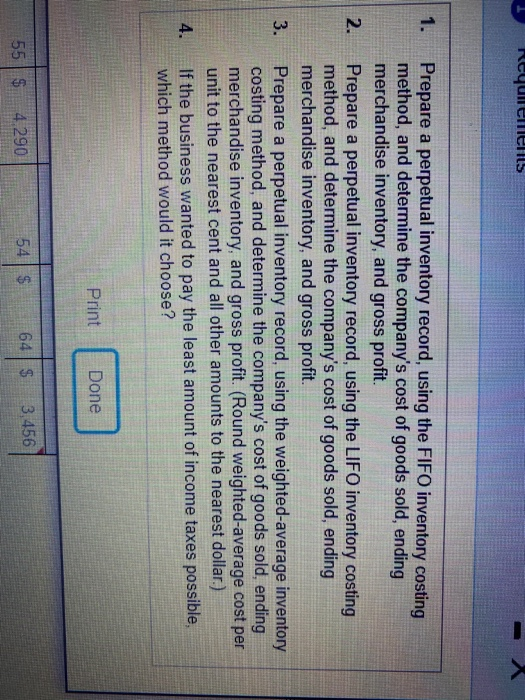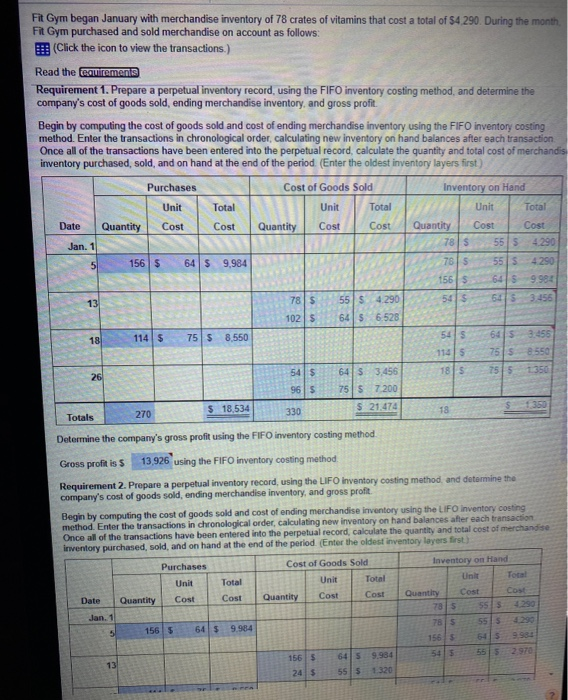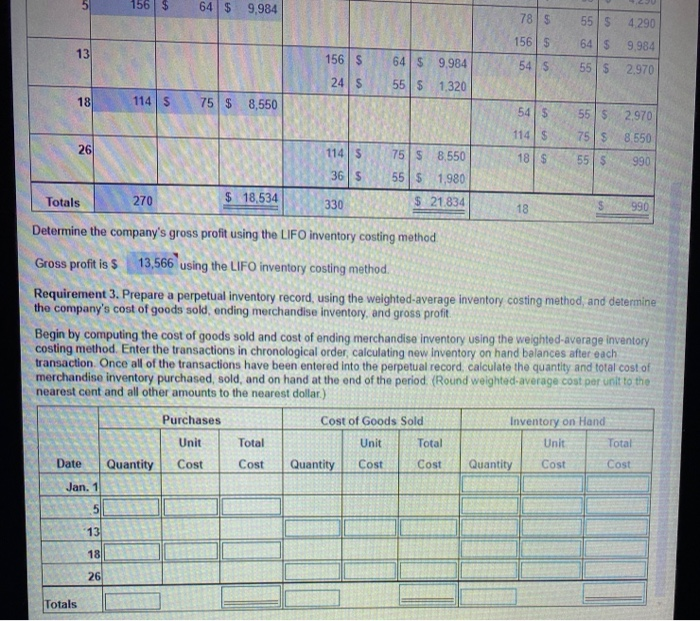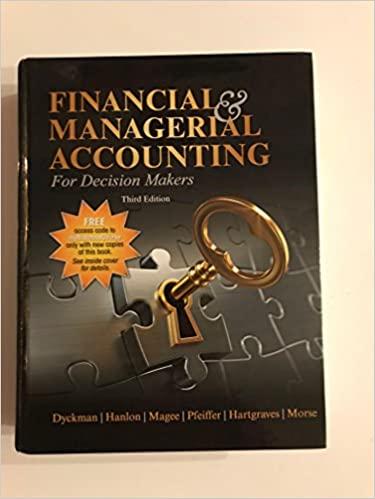Requiremens 1. 2. Prepare a perpetual inventory record, using the FIFO inventory costing method, and determine the company's cost of goods sold, ending merchandise inventory, and gross profit. Prepare a perpetual inventory record, using the LIFO inventory costing method, and determine the company's cost of goods sold, ending merchandise inventory, and gross profit. Prepare a perpetual inventory record, using the weighted average inventory costing method, and determine the company's cost of goods sold, ending merchandise inventory, and gross profit . (Round weighted-average cost per unit to the nearest cent and all other amounts to the nearest dollar.) If the business wanted to pay the least amount of income taxes possible, which method would it choose? 3. 4. Print Done 55$ 4.290 54 $ 64 $ 3,456 Fit Gym began January with merchandise inventory of 78 crates of vitamins that cost a total of 54.290. During the month. Fit Gym purchased and sold merchandise on account as follows: Click the icon to view the transactions.) Read the requirements Requirement 1. Prepare a perpetual inventory record, using the FIFO inventory costing method, and determine the company's cost of goods sold, ending merchandise inventory, and gross profit. Begin by computing the cost of goods sold and cost of ending merchandise inventory using the FIFO inventory costing method. Enter the transactions in chronological order, calculating new inventory on hand balances after each transaction Once all of the transactions have been entered into the perpetual record, calculate the quantity and total cost of merchandis inventory purchased, sold, and on hand at the end of the period. (Enter the oldest inventory layers first) Purchases Cost of Goods Sold Inventory on Hand Unit Total Unit Total Unit Total Date Quantity Cost Cost Quantity Cost Cost Quantity Cost Cost Jan. 1 785 555 4290 5 156$ 64 $ 9,984 7815 555 4.290 1565 6415 9.984 78$ 55 $ 4.290 545 5413 3.456 1025 64 36.528 18 114 $ 75$ 8,550 545 645 3456 1145 755 8550 26 54 $ 64 $3,456 185 755 1350 96 | 75 $ 7.200 $ 18,534 270 $ 21.474 330 Totals $ 1350 18 Determine the company's gross profit using the FIFO inventory costing method Gross profit is s 13,926 using the FIFO inventory costing method Requirement 2. Prepare a perpetual inventory record, using the LIFO Inventory costing method and determine the company's cost of goods sold, ending merchandise inventory, and gross profit Begin by computing the cost of goods sold and cost of ending merchandise inventory using the LIFO inventory costing method. Enter the transactions in chronological order, calculating new inventory on hand balances after each transaction Once all of the transactions have been entered into the perpetual record, calculate the quantity and total cost of merchandise inventory purchased, sold, and on hand at the end of the period. (Enter the oldest inventory layers first) Purchases Cost of Goods Sold Inventory on Hand Unit Total Unit Total Unit Total Date Quantity Cost Cost Quantity Cost Cost Quantity Cost Com Jan. 1 785 55 54.250 156 $ 64 $9.984 785 555 1565 645 156 5 13 5415 645 9.984 555 2.970 245 5551320 156 $ 64 $ 9,984 785 156 $ 55 $ 4290 64 $ 9,984 55 $ 2.970 13 156 $ 645 9.984 54 245 55 $ 1.320 18 1145 75 $ 8,550 54 $ 55$ 2.970 1145 75$ 8.550 26 1145 18$ 55$ 990 36 S 75 $ 8,550 55 $ 1,980 $ 21.834 Totals 270 $ 18,534 330 18 990 Determine the company's gross profit using the LIFO inventory costing method Gross profit is $ 13,566 using the LIFO inventory costing method. Requirement 3. Prepare a perpetual inventory record, using the weighted average inventory costing method, and determine the company's cost of goods sold, ending merchandise inventory, and gross profit Begin by computing the cost of goods sold and cost of ending merchandise inventory using the weighted average inventory costing method. Enter the transactions in chronological order, calculating new inventory on hand balances after each transaction. Once all of the transactions have been entered into the perpetual record, calculate the quantity and total cost of merchandise inventory purchased sold, and on hand at the end of the period (Round weighted average cost per unit to the nearest cent and all other amounts to the nearest dollar) Purchases Cost of Goods Sold Inventory on Hand Unit Total Unit Total Unit Total Date Quantity Cost Cost Quantity Cost Cost Quantity Cost Cost Jan. 1 51 13 18 26 Totals









